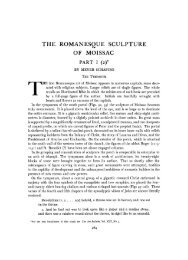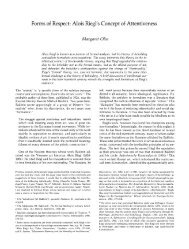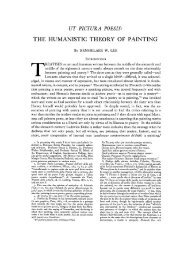Tragic Pompeii - College Art Association
Tragic Pompeii - College Art Association
Tragic Pompeii - College Art Association
You also want an ePaper? Increase the reach of your titles
YUMPU automatically turns print PDFs into web optimized ePapers that Google loves.
250 THE ART BULLETIN JUNE<br />
2<br />
1994 VOLUME LXXVI NUMBER 2<br />
6l1pcanemhigenaa<br />
-I<br />
Amazon frieze masks landscapes<br />
Phrixos Narcissus a<br />
S6a 6b 6<br />
M,<br />
Amphitrite & Achilles 6&<br />
_0Poseidon Agamemnon<br />
T Briseis & Helen<br />
I I I<br />
S6 12phgena<br />
-Alcestis &<br />
0 6 1 m ITheseuse<br />
14a' 14b16<br />
2<br />
HOUSE OF THE TRAGIC POET, POMPEII VI.8.3<br />
33 Plan showing locations of all figural scenes found in the house<br />
of love or honor.55 The compositional parallel between the<br />
naked figures of Iphigenia in the peristyle and Amphitrite<br />
back in the atrium (Fig. 26), both shown in the moment of<br />
being carried off, reinforced the persistent contrast within<br />
the house of exposed and confined women. There were<br />
other connections. Iphigenia, like Helen, was Argive; the<br />
sacrifice of her body to <strong>Art</strong>emis secured Greek success in the<br />
Trojan War; ostensibly, she died in order to save another<br />
woman, Helen. But her death was also a "maker of quarrels,"<br />
for it brought down her father, Agamemnon, the king of the<br />
Greeks.<br />
That same king could be seen in the atrium quarreling<br />
over the fate of still another woman, Briseis. The analogy<br />
55The digitally reconstructed photo in Fig. 32 originated in two<br />
separate 35mm slides, one of the site and the other of the panel in<br />
Naples. Both slides were scanned and then imported into Boston Photo<br />
Lab's Kodak Premier Image Enhancement System. From here the two<br />
images were combined by digital artist John McKnight and then output<br />
on LVT high-resolution film recorder as a 4 x 5mm transparency.<br />
between Iphigenia and Briseis is made by Achilles himself<br />
when, after reconciling with Agamemnon, he wishes Briseis<br />
had died like Iphigenia rather than cause a fight between<br />
men: "Agamemnon-was it better for both of us, after all, for<br />
you and me to rage at each other, raked by anguish,<br />
consumed by heartsick strife, all for a young girl? If only<br />
<strong>Art</strong>emis had cut her down at the ships-with one quick<br />
shaft-that day I ... chose her as my prize." Agamemnon<br />
blames their quarrel on Zeus, Fate, and Fury, and especially<br />
on Ruin, the eldest daughter of Zeus; even Zeus, he says, was<br />
blinded by Ruin in the form of Hera's guile, "feminine as she<br />
is." Achilles agrees, addressing the god directly: "Father<br />
Zeus, great are the blinding frenzies you deal out to men! If<br />
not, I swear, Atrides could never have roused the fury in me,<br />
the rage that would not die, or wrenched the girl away<br />
against my will."56 In the epic context, the traffic in women<br />
56 lzad 19.56-60; 86-94, trans. Fagles, 490-491, 497.










